There is no quiet place in the white man’s cities, no place to hear the leaves of spring or the rustle of insects’ wings. Perhaps it is because I am a savage and do not understand, but the clatter only seems to insult the ears.
Chief Seattle
The more we exile ourselves from nature, the more we crave its miracle waters.
Diane Ackerman
These are turbulent times in which we live. A pandemic disease has many of us fearful of visiting even close friends and relatives. Our federal government appears to be in a state of dysfunction more often than not. Right, left, and in-between seem to constantly be at one another’s throats. Conspiracy theories often carry more weight than verifiable data. It is all downright discouraging.
But there is a panacea. I am fortunate; all I must do to receive this remedy is step outside. Admittedly this therapy may not be permanent. But it can be at least a temporary escape from all that is folly and this treatment can be taken over and over again. There are no undesirable side effects. I am speaking of the little dramas and comforting sounds provided by the natural world. They are reminders that my worries, stressors, and fears are but interludes in the larger symphony. Playing unabated and undiminished in the background, this opus offers us a chance to pull away from our anxieties and re-center ourselves.
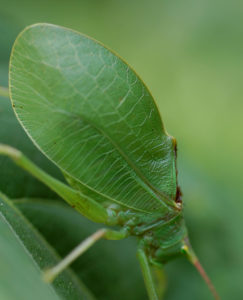 As I write, it is now July. Likely I could be put into a time machine, shuffled forward and backward a few times and, when I emerged, still recognize late summer in Indiana. Common tree katydids, dusk-singing cicadas, snowy tree crickets, and other orthopterans provide a daily chorus of communicative racket. They remind me that the imperative to establish territory, find a mate, and persevere as a species beyond the cold winter to come is a powerful drive among the small, six-legged critters of the world too. I dare say the urge is every bit as potent as it is among head-butting bison or antler-entangled deer.
As I write, it is now July. Likely I could be put into a time machine, shuffled forward and backward a few times and, when I emerged, still recognize late summer in Indiana. Common tree katydids, dusk-singing cicadas, snowy tree crickets, and other orthopterans provide a daily chorus of communicative racket. They remind me that the imperative to establish territory, find a mate, and persevere as a species beyond the cold winter to come is a powerful drive among the small, six-legged critters of the world too. I dare say the urge is every bit as potent as it is among head-butting bison or antler-entangled deer.
Admittedly, I once reacted with dread to the onset of the clicking, buzzing, and vibratory rasping of these summer insects. As a teacher it reminded me that my hiatus from ten hour days and high stress levels would soon cease. I loved my profession but who doesn’t relish having time to simply do as one pleases? Happily, I now find the multitudinous chorus performing outside my door to be not only entertaining but quite beautiful (https://www.youtube.com/watch?v=_wua2tULh84).
August will be here soon. The insect choirs will continue for a while of course. The evenings will offer the exquisite sound of wood thrushes calling from the forest just beyond my lawn (https://www.youtube.com/watch?v=f-22ZuQyAJ4). The hot, still days will be punctuated by the hollow-wooden cowlp, cowlp, cowlp, cowlp calls of a yellow-billed cuckoo. Likely the author of these sounds will be well-hidden and skulking about in the patch of woods to the west of the house. (https://www.allaboutbirds.org/guide/Yellow-billed_Cuckoo/sounds). Other August sounds bring me memories of childhood. The plaintive trill of a field sparrow bouncing to its conclusion carries me back to the hot days of summer when I roamed the oldfields around home in search of adventure (https://www.allaboutbirds.org/guide/Field_Sparrow/sounds).
course. The evenings will offer the exquisite sound of wood thrushes calling from the forest just beyond my lawn (https://www.youtube.com/watch?v=f-22ZuQyAJ4). The hot, still days will be punctuated by the hollow-wooden cowlp, cowlp, cowlp, cowlp calls of a yellow-billed cuckoo. Likely the author of these sounds will be well-hidden and skulking about in the patch of woods to the west of the house. (https://www.allaboutbirds.org/guide/Yellow-billed_Cuckoo/sounds). Other August sounds bring me memories of childhood. The plaintive trill of a field sparrow bouncing to its conclusion carries me back to the hot days of summer when I roamed the oldfields around home in search of adventure (https://www.allaboutbirds.org/guide/Field_Sparrow/sounds).
September is a lovely month. There are finally some equable evenings and more moderate days to enjoy. But plunked down here in southwestern 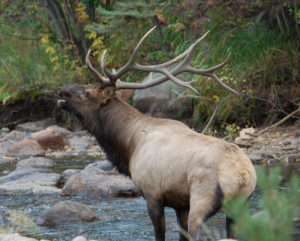 Indiana, I cannot prevent my mind from wandering westward. The foothills of Rocky Mountain National Park or the lodgepole pine forests of Yellowstone exert a pull that is tangible. For I know it is in such places that the bull elk are into their rut. I had long wanted to hear their fantastical bugling for myself. As soon as I found myself free in this month, I went in search. What a strange, far-carrying, high-pitched sound I found issuing from such a large animal (https://www.youtube.com/watch?v=pYzWmKlZtrU). Nowadays, I can listen to a recording of the bugling of an elk and find myself transported to another land. The smell of pine upon the air, the solitude of wilderness, the chill of a clear mountain morning, the distant clack of opposing antlers sounding from somewhere within the forested slope up above – all these reside within the bull’s weirdly wonderful bellow.
Indiana, I cannot prevent my mind from wandering westward. The foothills of Rocky Mountain National Park or the lodgepole pine forests of Yellowstone exert a pull that is tangible. For I know it is in such places that the bull elk are into their rut. I had long wanted to hear their fantastical bugling for myself. As soon as I found myself free in this month, I went in search. What a strange, far-carrying, high-pitched sound I found issuing from such a large animal (https://www.youtube.com/watch?v=pYzWmKlZtrU). Nowadays, I can listen to a recording of the bugling of an elk and find myself transported to another land. The smell of pine upon the air, the solitude of wilderness, the chill of a clear mountain morning, the distant clack of opposing antlers sounding from somewhere within the forested slope up above – all these reside within the bull’s weirdly wonderful bellow.
October brings its own enchantments. Now the nights are not just cool but may bring the chance for frost. Migrations are well under way for most bird species and for the next couple of months a rich smorgasbord of avian sounds may be encountered. I now have the good fortune to live less than ten miles from a 9000 acre wetland restoration known as Goose Pond Fish & Wildlife Area. Following its establishment in 2005, wetland and grassland birds of many species followed the now familiar axiom of “build it and they will come.”
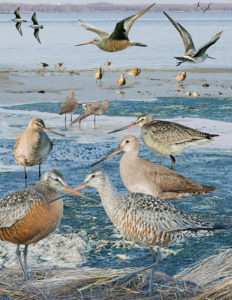 A visit to this area in late summer or early fall allows one to be serenaded with the vocalizations of waterfowl and shorebirds by the thousands. They use the property to rest and fuel up for the journeys ahead. Some may go no further than the southern U.S. but others are in the midst of migratory journeys of epic proportions. I was astounded when I first learned that among the sojourners was a bird known as the Hudsonian godwit. (www.allaboutbirds.org/guide/Hudsonian_Godwit/sounds) Why? It is simply this; few other birds embark on flights as monumental as does this nine ounce avian marvel. The godwits at Goose Pond are thought to be arriving from eastern Alaska or northwestern Canada. Are they making the flight to SW Indiana nonstop? I do not know for sure. It is known that they are quite capable of such feats. Hudsonian godwits have been tracked making an uninterrupted, five day flight of some 3900 miles from Hudson Bay, Canada to the Orinoco River basin of Venezuela. Their eventual
A visit to this area in late summer or early fall allows one to be serenaded with the vocalizations of waterfowl and shorebirds by the thousands. They use the property to rest and fuel up for the journeys ahead. Some may go no further than the southern U.S. but others are in the midst of migratory journeys of epic proportions. I was astounded when I first learned that among the sojourners was a bird known as the Hudsonian godwit. (www.allaboutbirds.org/guide/Hudsonian_Godwit/sounds) Why? It is simply this; few other birds embark on flights as monumental as does this nine ounce avian marvel. The godwits at Goose Pond are thought to be arriving from eastern Alaska or northwestern Canada. Are they making the flight to SW Indiana nonstop? I do not know for sure. It is known that they are quite capable of such feats. Hudsonian godwits have been tracked making an uninterrupted, five day flight of some 3900 miles from Hudson Bay, Canada to the Orinoco River basin of Venezuela. Their eventual 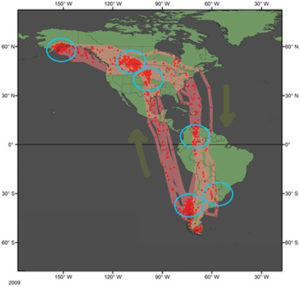 destination is southern Chile, some ten thousand miles from their breeding grounds. Is this the destination of our Goose Pond godwits? Quite likely it is. And the mere thought of such a feat of physical endurance and navigational shrewdness leaves me flabbergasted.
destination is southern Chile, some ten thousand miles from their breeding grounds. Is this the destination of our Goose Pond godwits? Quite likely it is. And the mere thought of such a feat of physical endurance and navigational shrewdness leaves me flabbergasted.
November can be a bit of a downer here in Indiana. Gray, dull skies, yielding days without sunshine and cold rains are recollections that come to my mind. But there is an entertaining trade-off; the lingering waterfowl provide a near-daily concert meant to lighten my mood. The flocks of geese, which nightly roost in the wetland to the east, make daily passages over my house. They are heading to, and from, the waste grain bonanza lying in the harvested fields of the Wabash River bottoms to the west.

Canada geese are commonly seen. Years ago, when I was a youngster, our family would take excited note of these birds as they passed overhead. In the fall, flocks heading southward served notice that the warm, pleasant days of summer were soon to be replaced by cold, blustery winds. In March, the sound of Canada geese forging northward in ‘V’ after ‘V’ caused us to bolt from the house and take a look skyward. Harbingers of spring they were, welcome messengers announcing that a break from cold, sleet, and snow was nearly upon us.
These days hardly anyone takes special notice of Canada geese unless to complain that they are fouling lawns or fairways. Many of them no longer migrate but remain here in the Midwest year round. Mild winters, the aforementioned agricultural fields, and an abundance of lakes which seldom freeze over for long mean their long annual trips are no longer necessary.
Recently some other players have joined the cast providing the daily  entertainment proffered me by the goose clan. The formations passing over my house are now more frequently comprised of greater white-fronted geese. Their high pitched, yelping calls allow me to hear them approaching from a distance and bear little resemblance to the deep honks of their Canadian cousins (https://www.allaboutbirds.org/guide/Greater_White-fronted_Goose/sounds).
entertainment proffered me by the goose clan. The formations passing over my house are now more frequently comprised of greater white-fronted geese. Their high pitched, yelping calls allow me to hear them approaching from a distance and bear little resemblance to the deep honks of their Canadian cousins (https://www.allaboutbirds.org/guide/Greater_White-fronted_Goose/sounds).
Of late, snow geese have taken to forming winter aggregations at Goose Pond. Later in the year, they will linger and rest there by the tens of 
thousands. Their dispersal flights from the wetland are a thing to behold as echelon after echelon climb away and pass into the distance. At my place their high, nasal honks fill the air as they eagerly speed overhead bound for the bottomland corn fields to the west https://www.allaboutbirds.org/guide/Snow_Goose/sounds).
I give a silent thanks to the goose species passing above me. They lighten the gloomy November skies with a reminder that the rhythms of nature still persist. Their calls and massed numbers are also proof that wildlife spectacles happen not just on TV but right around us, if we will only look.
These birds prompt me to recall the delightful observation conservationist Aldo Leopold made regarding our good fortune in hearing the conversation of geese overhead. As he watched Canada geese pass northward over his Wisconsin farmstead in the spring, he observed that, “. . . in this annual barter of food for light, and winter warmth for summer solitude, the whole continent receives as net profit a wild poem dropped from the murky skies upon the muds of March.”
Now, what to make of December? Here is a verse from Thomas Parson’s poem recognizing this month.
You are calm,
You allow me to slow,
To envelope the tranquility I crave.
The month seems a quiet one to me too. A good book and a hot cup of tea sound appropriate. Outside my window, nature has slowed too. I may see a white-tailed deer looking gray and showing its ribs wander by, pausing occasionally to nibble at a tree bud. It looks like mighty tough going out there.
Unlike the clamorous months that have just passed, the world seems to have gone strangely silent. Much of my December amusement from Mother Nature now comes in the form of the many woodpecker species inhabiting my woods. Shunning the warmth of more southern climes, they stick it out through the challenging winter. Utilizing their uncanny ability to detect insects and their larvae hidden within the woody tissue of the many diseased or dead trees around me, they persevere with admirable fortitude. They are a very busy bunch indeed.
 My favorite is the pileated woodpecker. Strikingly huge (the size of a crow) with equally conspicuous plumage, they seem a good candidate for King of Woodpeckers. Their call rings loudly through the barren, otherwise somber forest. The wedge-shaped cavities they chop into trees are equally impressive due to their large size. Yes, I am quite happy to have pileated woodpeckers as close neighbors. They much enliven an otherwise quiet December (https://www.allaboutbirds.org/guide/Pileated_Woodpecker/sounds).
My favorite is the pileated woodpecker. Strikingly huge (the size of a crow) with equally conspicuous plumage, they seem a good candidate for King of Woodpeckers. Their call rings loudly through the barren, otherwise somber forest. The wedge-shaped cavities they chop into trees are equally impressive due to their large size. Yes, I am quite happy to have pileated woodpeckers as close neighbors. They much enliven an otherwise quiet December (https://www.allaboutbirds.org/guide/Pileated_Woodpecker/sounds).
January usually brings some visitors from the north. I see several sparrow species that have been absent since last winter. Fox sparrows, tree sparrows, white-crowned and white-throated sparrows work busily under my bird feeders. Dark-eyed juncos are here now too. Snowbirds my grandparents used to call them. The occasional yellow-bellied sapsucker joins the woodpecker fraternity that makes my woods their home.
These days I am fortunate enough to make my own migration. Heading south, we set our GPS for the “Nature Coast” of western Florida. Here, for a few weeks, we can forget the cold winds and leaden skies of winter-time 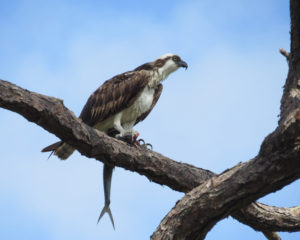 Indiana. A favored sound here is the high-pitched, piping, whistle of the osprey (https://www.allaboutbirds.org/guide/Osprey/sounds). What fun it is to watch them patrolling the Chasshowitzka, Homosassa, or Crystal Rivers in search of their piscine prey. There are brown pelicans to watch as they wheel and plunge-dive for fish
Indiana. A favored sound here is the high-pitched, piping, whistle of the osprey (https://www.allaboutbirds.org/guide/Osprey/sounds). What fun it is to watch them patrolling the Chasshowitzka, Homosassa, or Crystal Rivers in search of their piscine prey. There are brown pelicans to watch as they wheel and plunge-dive for fish 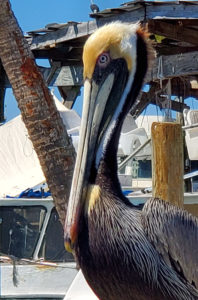 themselves. American white pelicans are here too. I wonder if I have seen any of these individuals at Goose Pond as, earlier in the year, they migrated southeast from their summer home in the northern Great Plains.
themselves. American white pelicans are here too. I wonder if I have seen any of these individuals at Goose Pond as, earlier in the year, they migrated southeast from their summer home in the northern Great Plains.
Of course there are many other distractions. Manatees congregate in the warmer freshwater springs of the area. Gopher tortoises and armadillos patrol the pines and scrub of the Withlacoochee State Forest. All in all it is, for Hoosier eyes, an exotic show that is provided by this brief winter escape to the subtropics. 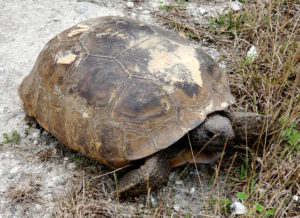
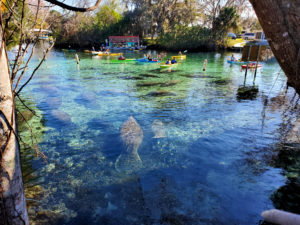
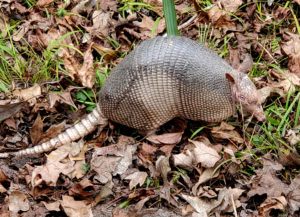 An Indiana February, in spite of the continued cold weather, is a month with much merit for the naturalist. Although spring is technically weeks away, the first signs that nature is beginning to stir come this month. According to my field notes, mid-February is often heralded by the first, tentative, often feeble calls of the chorus frogs (https://www.youtube.com/watch?v=hzePgnIpUuk). Surely, I think to myself, the icy grip of winter must be
An Indiana February, in spite of the continued cold weather, is a month with much merit for the naturalist. Although spring is technically weeks away, the first signs that nature is beginning to stir come this month. According to my field notes, mid-February is often heralded by the first, tentative, often feeble calls of the chorus frogs (https://www.youtube.com/watch?v=hzePgnIpUuk). Surely, I think to myself, the icy grip of winter must be 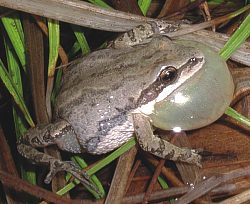 easing if these tiny singers can manage to advertise their re-emergence into the world.
easing if these tiny singers can manage to advertise their re-emergence into the world.
There is action overhead too. Arriving a couple of weeks earlier than they did just a few years ago, come phalanx after phalanx of sandhill cranes. If I had to choose a bird species which above all others evokes wildness by voice alone, I should have to choose the call of these birds. How wild and far-carrying their rattling, bugling voice is (https://www.youtube.com/watch?v=KpTykjLYYr0). Often times I search in vain for the source of these ancient, mesmerizing sounds coming from somewhere overhead. They are often too high, too far away for me to locate. Although unseen, their calls hang upon the air as if the biosphere itself was gifted with the ability to speak.
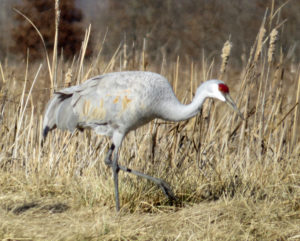 Their speech represents an exceptional story of conservation success. Once nearly extirpated east of the Mississippi, there are now almost 100,000 sandhill cranes in their eastern
Their speech represents an exceptional story of conservation success. Once nearly extirpated east of the Mississippi, there are now almost 100,000 sandhill cranes in their eastern  population. An evening spent just before sunset at Goose Pond FWA is an event to be recommended. The sight of thousands of sandhill cranes returning to their evening roost and filling the air with their announcements of arrival will, I guarantee, stir even the stodgiest soul.
population. An evening spent just before sunset at Goose Pond FWA is an event to be recommended. The sight of thousands of sandhill cranes returning to their evening roost and filling the air with their announcements of arrival will, I guarantee, stir even the stodgiest soul.
In March, the average daytime temperature has reached 530F and even the nights are often above freezing. I abhor the cold more and more with each passing year, what a relief this is. The wildlife around my rural home 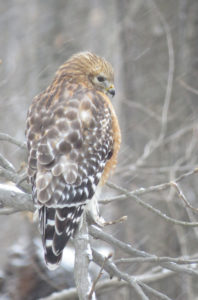 respond too. Red-shouldered and Cooper’s hawks seem to find my little stand of timber to their liking as a nesting area. Both species are raucous and enthusiastic vocalizers and fill the day with their loud territorial and courtship calls (https://www.allaboutbirds.org/guide/Red-shouldered_Hawk/sounds /).
respond too. Red-shouldered and Cooper’s hawks seem to find my little stand of timber to their liking as a nesting area. Both species are raucous and enthusiastic vocalizers and fill the day with their loud territorial and courtship calls (https://www.allaboutbirds.org/guide/Red-shouldered_Hawk/sounds /).
(https://www.allaboutbirds.org/guide/Coopers_Hawk/sounds)
We have owls too and their vocalizations continue in March. The hooting of  great-horned owls issues forth from our woods and is shortly answered by a neighbor across the road to the north (https://www.allaboutbirds.org/guide/Great_Horned_Owl/sounds). “This is my spot says one. OK, but this is my spot over here,” says the other. Barred owls entertain us with their familiar “who cooks for you” call (https://www.allaboutbirds.org/guide/Barred_Owl/sounds).
great-horned owls issues forth from our woods and is shortly answered by a neighbor across the road to the north (https://www.allaboutbirds.org/guide/Great_Horned_Owl/sounds). “This is my spot says one. OK, but this is my spot over here,” says the other. Barred owls entertain us with their familiar “who cooks for you” call (https://www.allaboutbirds.org/guide/Barred_Owl/sounds).
For some time, after moving to our house in the woods, we were puzzled by a night sound of exquisite eeriness. Our grandchildren were quite terrified by the creepiness of the calls we heard. But we eventually all agreed that we must go out into the pitch-black night and try to discover the source of our trepidation. The next time we heard the strange high-pitched call, which seemed to rise in pitch and then abruptly stop we armed ourselves with flashlights and ventured out. The voice was cryptically difficult to locate but we eventually traced it to a small redbud tree along the edge of our lawn. Shining our lights into the tree revealed the culprit –a barred owl (https://us.napster.com/artist/cornell-lab-of-ornithology/album/voices-of-north-american-owls-vol-2/track/barred-owl-female-solicitation-call). Our curiosity satisfied and our disquiets allayed, the grandkids and we can now listen with tranquility to the eerily strange solicitation call issuing from the nocturnal woodlands.
April, with its influx of returning migratory birds, offers a daily increase in participants joining the avian chorus outside the door. The morning chorus and warming temperatures are bound to lift one’s spirits after a long winter. But I am also heartened by the increasing number of amphibians adding their “two cents worth” to the chorale that is springtime Indiana. As noted, the chorus frogs got an early start. They were soon joined by wood frogs and spring peepers. Now, in April, I begin to also notice the voices of leopard frogs, green frogs, bullfrogs, gray tree frogs, and Fowler’s toads.
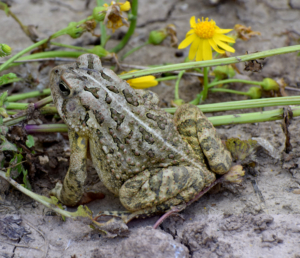 Just over a rise behind the house lies our neighbor’s pond. It isn’t long after the weather begins to really warm that my evenings will be enhanced by the pleasant buzzing of the countless Fowler’s toads which congregate there (www.youtube.com/watch?v=ezHxi2DEHOE). From now throughout much of the remainder of the summer, their odd falsetto bleats will provide palliative background music for a meditative sit on the front porch. The mating calls of bullfrogs will soon join the toad chorus (www.youtube.com/watch?v=VaP9cac3cPI). Their booming expressions reverberate across the wetlands reminding all who can hear that they are indeed the biggest frog in the puddle.
Just over a rise behind the house lies our neighbor’s pond. It isn’t long after the weather begins to really warm that my evenings will be enhanced by the pleasant buzzing of the countless Fowler’s toads which congregate there (www.youtube.com/watch?v=ezHxi2DEHOE). From now throughout much of the remainder of the summer, their odd falsetto bleats will provide palliative background music for a meditative sit on the front porch. The mating calls of bullfrogs will soon join the toad chorus (www.youtube.com/watch?v=VaP9cac3cPI). Their booming expressions reverberate across the wetlands reminding all who can hear that they are indeed the biggest frog in the puddle.
Come April, Anne and I will be enjoyably distracted by gray tree frogs which love to perch on our patio doors at night. How they seem to instinctively 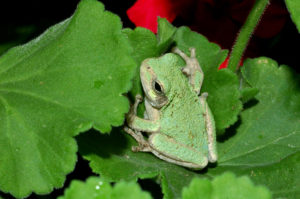 know that porch lights attract insects is a mystery to me. But, there they are; hovering just beyond the lights ready to gulp down any passing midge or bug that makes the mistake of landing near them. Gray tree frogs are of two species, the eastern gray treefrog and Cope’s gray treefrog. They are differentiated by voice and it is mostly the latter which hangs around our home. Little snatches of song emanating from the surrounding trees are steady reminders of their presence out beyond our doors and windows (https://www.youtube.com/watch?v=96W0crcrb_s).
know that porch lights attract insects is a mystery to me. But, there they are; hovering just beyond the lights ready to gulp down any passing midge or bug that makes the mistake of landing near them. Gray tree frogs are of two species, the eastern gray treefrog and Cope’s gray treefrog. They are differentiated by voice and it is mostly the latter which hangs around our home. Little snatches of song emanating from the surrounding trees are steady reminders of their presence out beyond our doors and windows (https://www.youtube.com/watch?v=96W0crcrb_s).
One note of warning; I occasionally must relocate gray treefrogs who seem to love hiding under our outdoor grill cover. Once, after doing so, I proceeded to unthinkingly rub my eyes. The immediate result was a feeling akin to a shot of mild pepper to the face. Many amphibians have toxic skin secretions which protect them from predators. So does the gray treefrog I found.
May is a highly anticipated month at our house. We eagerly await the arrival of a migrant who will provide hours of free entertainment for the next few months. While its vocalizations are neither highly melodic nor exceptional, the physical abilities, agility, acrobatic mating displays, and sheer beauty of the ruby-throated hummingbird are second to none  (https://www.allaboutbirds.org/guide/Ruby-throated_Hummingbird/sounds). Although we usually try to anticipate their arrival by having feeders ready, these tiny motes of energy sometimes surprise us. We have, on a couple of occasions, awoken to find a hungry, early arrival hovering outside our bedroom window. Peering inside, it seems to be suggesting quite clearly “Hey, get your lazy butts out of bed and get that sugar water out here!”
(https://www.allaboutbirds.org/guide/Ruby-throated_Hummingbird/sounds). Although we usually try to anticipate their arrival by having feeders ready, these tiny motes of energy sometimes surprise us. We have, on a couple of occasions, awoken to find a hungry, early arrival hovering outside our bedroom window. Peering inside, it seems to be suggesting quite clearly “Hey, get your lazy butts out of bed and get that sugar water out here!”
June is a favored month. Some dependably warm weather brings an invitation to get outside. There is gardening, mowing, weeding and a hundred other chores to be done. I can cut back on trips to the gym; there will be lots of exercise from now until the frosty days of late fall.
There is a sound I associate from childhood with this pleasant, verdant month too. Sadly, it is a voice that is much less common than it once was. I speak of the clear, unmistakable call of the bobwhite. When I was a youngster, the voice of this little quail was an ever-present component of 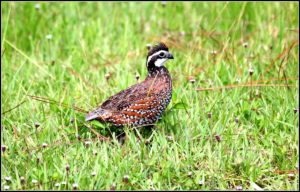 life outside the house. Whether it was the high-pitched territorial “bob-white” or the melodic covey call used to group and stay in contact, their vocalizations were as fixed and familiar as the sun traversing the June sky https://www.allaboutbirds.org/guide/Northern_Bobwhite/sounds. Sadly, years of habitat loss and fragmentation have caused their numbers to plummet by as much as 70-90%. Recently a covey near home comprised of nine birds flushed before me. I realized it was one of the larger I had seen in a while. But I also recognized it as a pitiful fraction of the numbers I encountered as a boy. I recall encountering coveys decades ago that often numbered 40 or 50 birds.
life outside the house. Whether it was the high-pitched territorial “bob-white” or the melodic covey call used to group and stay in contact, their vocalizations were as fixed and familiar as the sun traversing the June sky https://www.allaboutbirds.org/guide/Northern_Bobwhite/sounds. Sadly, years of habitat loss and fragmentation have caused their numbers to plummet by as much as 70-90%. Recently a covey near home comprised of nine birds flushed before me. I realized it was one of the larger I had seen in a while. But I also recognized it as a pitiful fraction of the numbers I encountered as a boy. I recall encountering coveys decades ago that often numbered 40 or 50 birds.
Today the bobwhite is masquerading as a canary in our coal mine I’m afraid. I’m equally certain of two other things. The decline of the bobwhite in our time is permanent and sadly enough, most people won’t even notice the difference.
So, there you have it. You have seen one way in which I measure my year; one avenue for escaping the mind-disturbing inanities and frustrations of life in today’s world. These are months filled with gratitude at being able to still hear the persistent, calming melody of the Creation.
The ancestors of the katydids, crickets, and grasshoppers calling outside my window appear as fossils in Pennsylvanian aged rock formed from sediments laid down 300 million years ago. It comforts me to connect with earth’s deep history through listening to Nature. In this way, I am reminded that in an age of pandemics, inane politicians, personal and societal decisions abetted by scientific illiteracy, the natural world still plugs along. It has done so for a span of time that is incomprehensibly long. Nature will continue to do so in spite of the chaos and communal dysfunction which now seem to characterize our species, Homo sapiens.
The sounds and dramas of the natural world soothe us. They reconnect and re-center us emotionally. They do so by reminding us of our lengthy lineage as hunter-gatherers and our innate dependence upon the gifts of the natural world. They should also cause us to deeply reflect upon an observation made by Chief Thomas Rainwater. I paraphrase him here: “If we continue our assault on the planet’s ecosystems, Mother Earth is quite capable of – as a grazing bison might dislodge an annoying fly – simply shrugging us off and going it alone.”
Photo Credits: wood thrush by Rhododendrites @ commons.wikimedia.org Hudsonian godwit in Crossley's ID Guide: Eastern Birds Hudsonian godwit migration map @ ResearchGate.net Canada goose by Alan D. Wilson @ commons.wikimedia.org greater white-fronted goose by Ken Conger @ commons.wikimedia.org snow goose flock by Ray Hennessey @ commons.wikimedia.org pileated woodpecker by Andy Reago & Chrissy McClarren @ comm.wiki.org chorus frog by Ohio Dept. of Nat. Res. @ commons.wikimedia.org Fowler's toad by Aaron Sather @ commons.wikimedia.org bobwhite quail by cuatok77 @ commons.wikimedia.org All Other Photographs by the Author.
